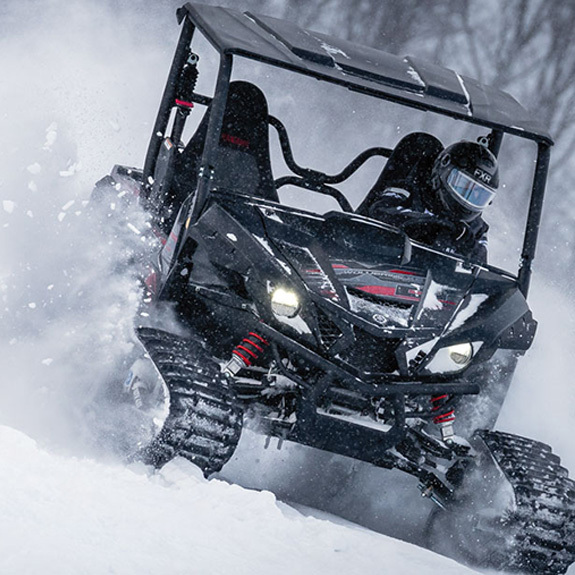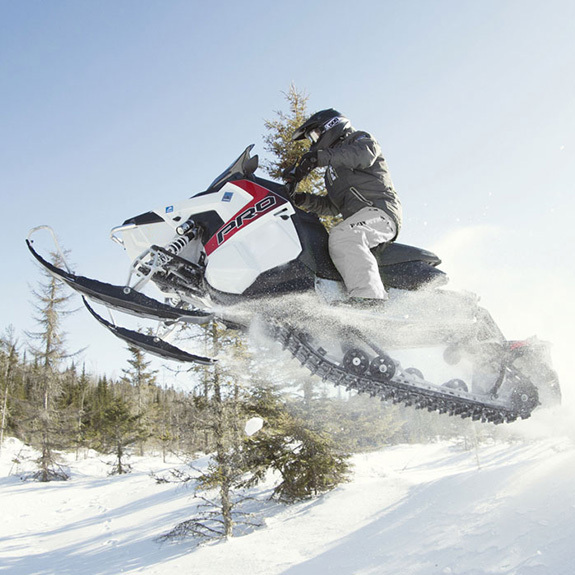What’s behind the new Camso Hurricane 175 snowmobile track?
We recently sat down with Bruce Dashnaw, Sales & Customer Service Executive Director – Powersports at Camso, to talk about the new Hurricane 175 snowmobile track, launched earlier this fall during Hay Days
A lifelong powersports enthusiast, Dashnaw has over 20 years of experience working in the industry and collaborating to the introduction of some of the most innovative snowmobile track designs on the market. We picked his brain to learn more on what inspired the development of this new cross country track, so we can better picture what snowmobilers will experience riding it this winter:
Camso: Hi Bruce! Could you share with us what sparked the inspiration for developing the new Hurricane 175 track?
Dashnaw: The cross country, or crossover, segment group of snowmobiling is very popular and we wanted to create something to inspire those riders. It’s really the first time where we started from a mountain track to develop a trail track. We inspired ourselves from the lug and all of the efficiencies and columns found in a mountain track, and then reduced the lug to create a crossover track. It is quite unusual, but this innovative design process ensures we conceive a track that performs in both environments.
Camso: What kind of riding style is this track designed for? Which riders would get the most out of this track?
Dashnaw: It’s primarily for trail riders who are looking to do more off-trail riding. With the Hurricane 175 track design, we incorporate some of the deep snow technology with trail track technology. The result is a track that is more efficient than other cross country designs, while providing maximum performance across a variety of conditions. So when a rider is on a trail and they find an open meadow, they can get out and enjoy it where it is allowed. Riders should conduct off-trail riding only in areas where it is allowed/approved. Check with local snowmobile clubs if you are not sure.
Camso: Excellent! But tell us, what makes the Hurricane 175 different?
Dashnaw: The key difference is in the outer lug design. The lug columns are strategically positioned to provide the right balance of flex and rigidity so that you still get a smooth ride on the harder surfaces, and at the same time the track has enough flex on other parts of the lug for that sought-after deep snow performance.
Camso: Sure, so what would you say are the key benefits in terms of performance? Because, let’s be honest, performance is what we’re into!
Dashnaw: Most of the crossover sleds come from the factory with a 1.25 or 1.5-inch lug height, so a 1.75 gives you better performance in deep snow. But it’s not like a dedicated mountain track with 2.5 or 3-inch lugs, so it is still comfortable and performs well on packed surfaces, such as trails.
Camso: Now, let’s get a little technical, if you don’t mind. Drive pitch: can you explain what it is, and why it’s important?
Dashnaw: Drive pitch is the distance between the internal drive lugs on the drive sprocket. This is where the term drive pitch comes from. Before 2008, the standard was a 2.52-inch drive pitch. With the 2.86 drive pitch you get overall about four pounds less weight. In our catalogue, we talk about drive pitch and lug heights to try to educate the riders about this. Riders need to be informed to be sure they get the right track for their riding style.
Camso: So, the right track for the right riding style would have to mean lug design is an important aspect of the Hurricane 175 track?
Dashnaw: A lot of the weight reduction is done through lug design. It all comes down to positioning the lug columns in the right place and with the proper geometry to benefit from the pressure points on the sled, and then you remove material from places where it wasn’t really serving any real purpose. Fifteen years ago lugs would span the width of the track. Over time we found that you could have a lot fewer lugs, but by having them in the right places, you could actually gain in traction and have all the performance needed, without all the extra weight and inefficiencies.
Camso: All in all, which snowmobile models, would you say, will benefit from the Hurricane 175 track?
Dashnaw: With its 2.86 drive pitch, it fits most 2008 and newer trail and crossover snowmobile makes and models. If you’re still not sure, go to our website and use our track selector tool: https://camso.co/en/snowmobile/products
Camso: Pretty versatile! And to keep things running smoothly, when, or how often, should a snowmobile track be replaced?
Dashnaw: You should check your track annually for worn or torn lugs or excessive wear. Your outer lugs can get rounded off or they can break off at the base, so then under load they just fold. Like tires on your car or truck, the condition of your track and having the right track for your riding style makes a significant difference in your overall riding experience. It’s not uncommon that I hear from people that they change their track and it’s like they have a whole new snowmobile again. It makes that much of a difference.
Camso: Thanks so much for the tips and the inside scoop.
There you have it, folks! If you are looking to get the most out of riding your snowmobile and don’t want to get left behind this winter, changing your snowmobile track might be something you want to look into. And if cross country is your thing, the new Hurricane 175 might be exactly what you’ve been looking for.



























